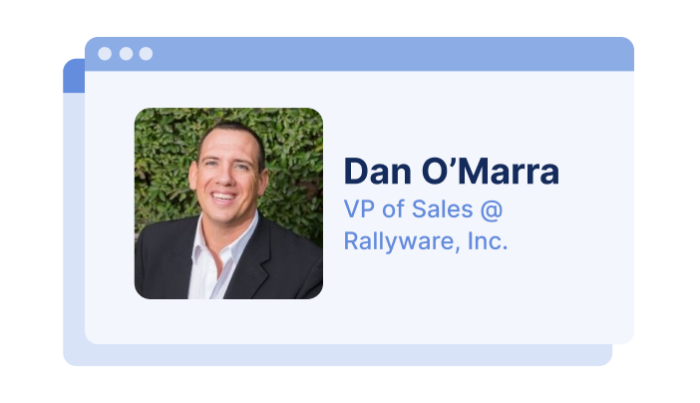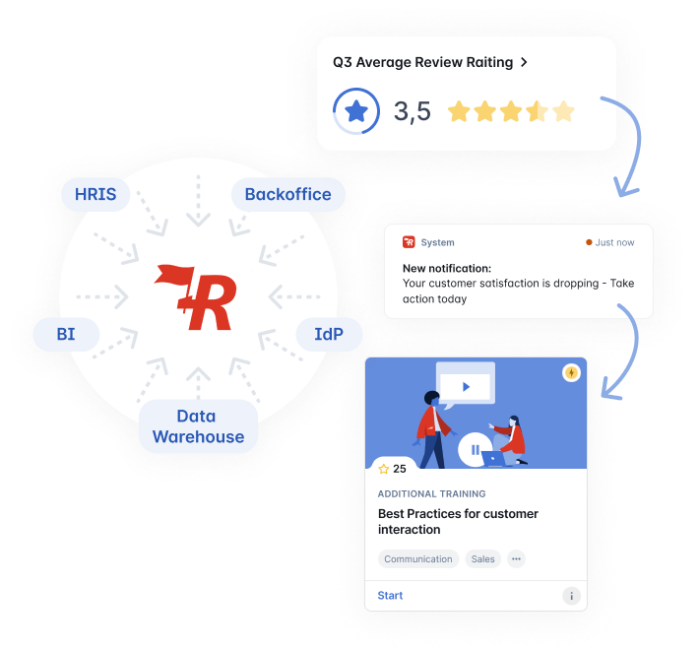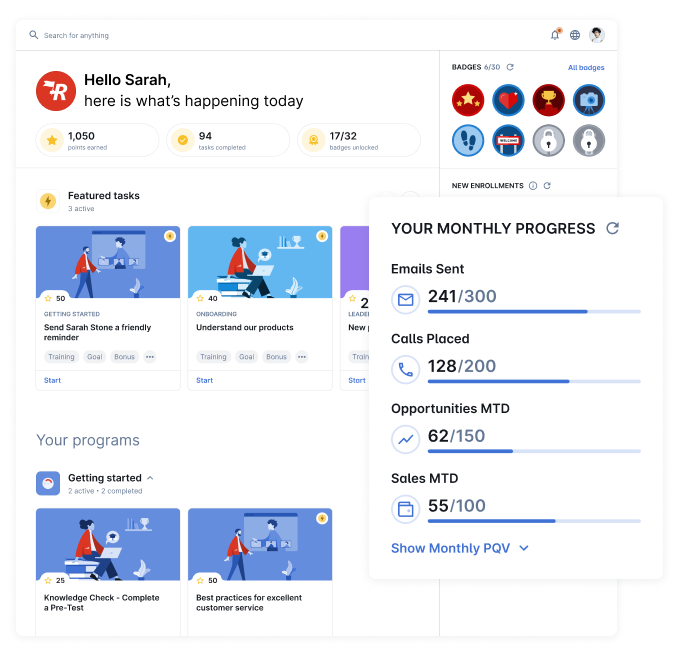3 Ways to Drive Continuous L&D for Gig Workers
The Present and Future of Direct Selling: an Interview with Rallyware’s Dan O’Marra
As an expert in direct selling software and a seasoned sales executive, Dan O’Marra is part of the lifeblood of Rallyware. VP of Sales for the company, Dan delivers over a decade and a half of experience in sales strategizing, process building, and business development that drives innovation and helps lock down client success.
Dan’s position affords him a particularly insightful view of direct selling, related industries like retail and franchise, and the digital transformation. He communicates regularly with current and potential clients to get a sense of where the market is and what the major players expect and need out of their technology. He’s constantly evaluating the market to construct new ways of engaging the customer base, framing Rallyware’s inherent advantages, and adapting well ahead of technical and economic shifts.
In this article, we talk to Dan about where direct selling and gig work are right now, and where they are most likely headed – and how they rely on the digital transformation to succeed. Anyone who has spoken to Dan knows how deeply he understands his subject matter, and how easily he can translate complex topics into simple-to-follow ideas – qualities which are fully on display in the below.

Digitalization and Direct Selling Software: Career Overview
Tell us about your career so far. How did you make your way to Rallyware?
I’ve been in tech in one way or the other for 15 years.
My interaction with direct selling software started back about 10 years ago. I was helping to lead a technology company that automated social media for companies inside and outside of direct selling. That company ended up being sold, and then I was brought into another tech company to help out with the sales of their emerging digital product line and establishing a client success team.
While I was there, an industry consultant asked me to review a platform called Rallyware. I reviewed that product as it was intended for the franchise space. I got a demo from CEO and Co-Founder George Elfond and in response, gave a high-level overview of what I thought was needed for them to make Rallyware as useful as possible for the players in the franchise space. George was impressed; the rest is history. I was brought on board to sell Rallyware formally. Now I oversee all sales as VP of Sales.
Direct Selling Software Since COVID-19 and Today
Over the past two years, since the onset of the COVID-19 pandemic and the rise of remote workforces, how has direct selling changed?
I think this need arose to provide a smarter system, rather than a single standalone tool – a system that is both end-to-end and fully integrated with other sources of truth.
More people began engaging with gig opportunities, which became easier and easier to access and make money out of. Gig work requires lower cognitive loads for people to do the work than traditional work, which at a time of stress and uncertainty can be extremely valuable.
As you might know, gig work usually involves selling in some capacity. For example with AirBnb, I’m giving up capacity in my house to get money in return. As a response, the direct selling industry has had to try to get the benefits of participating in the industry as close as possible to the benefits of the gig economy. Reduce the cognitive load necessary to earn a dollar, in a manner of speaking. But you have to have smart systems to do that, to provide that experience, systems which actively guide the user toward her goals from onboarding to first sale and onward.
What pain points have emerged in 2022?
Well, we see a lot at play in the digital transformation. Companies are moving away from legacy experiences and technologies. While we see a lot of “cool tools” that have been developed and come out over the years, the core platforms – what we might call back office systems – are overwhelmingly legacy systems that have been in place for a long time.
What ends up happening for many companies is that they’re trying to mesh this innovative piece of functionality with a legacy back office experience. That doesn’t work that well when you do it piecemeal, creating a tech stack of “cool tools” and just throwing them on top of that legacy system willy-nilly. That creates a chaotic and non-viable distributor experience.
And so forward thinkers and disruptors in direct selling are pushing for a more modern consultant experience that, if you will, lies on top of the company’s legacy back office experience system.

Like I’ve said, this would be a smarter system, one which integrates the entire direct selling lifecycle, including data from other sources, into a single distributor experience.
Of course, this looks very different for large companies, because of the size of the organization, the technology needed to make that happen without impacting the flow of consultants, their ability to buy products and recruit people – that’s just going to be different versus a smaller company. But overall, there’s a big push for that modern, smart, and fully integrated back office experience.
How does Rallyware play into that?
With legacy systems you have a single user experience (UX) for everyone in the company. You’ll have people who are brand new and then people who are managing million dollar businesses: both will get the same experience, instead of matching the experience to the individual’s journey, needs, and goals. These are what you might call single-use systems, rather than smart systems – flexible systems which change to suit the user’s needs and wants.
Yes, UX needs to match the user’s needs. Otherwise whoever your end user is – whether that’s a direct selling distributor or a sales floor associate at a furniture store – can get bogged down, distracted, discouraged. You need a flexible UX that takes into account what my goals are and where I’m at relative to them, and flexibly provides an experience to match that.

The back office is a traditional place where the field would go and see what their commission structure looks like, how many people are on their team, and so forth. Now, however, smart systems are not just passive repositories of information, but suites that are actively helping to enable the distributor to sell.
If I can zoom outward for a second: this is what we at Rallyware have talked about as the modern distributor experience. This is much preferable to, and more effective than, the chaotic “cool tool” experience I talked about earlier, or the single one-size-fits-all UX I just referred to.
One of the things we’re doing is integrating into back office systems and extrapolating conclusions from that data in order to enable the distributor for higher performance. Obviously, this is a more complex topic, because the technology itself is complex – but overall, that’s the new horizon for smart systems in direct selling.
If right now we’re talking about direct selling software, I also see this same need in the franchise and retail spaces – this central intranet experience. For many companies, their UX or in-store experience is old right now, it’s clunky, it’s creating disengagement, and perhaps most importantly, it’s only been called out because others are providing that slicker, cleaner experience and an easier process, which is precisely what we do.
Looking Toward the Future
What will the next year look like, in your opinion?
Simplicity is going to be a big thing for 2023 and beyond. We’re going to see the simplification of compensation structures, simplifying the whole experience of onboarding, training, selling, contact relationship management. At a time when companies are competing for reps, it’s going to make a difference if you can provide a smart system that will make a previously complicated process into something easy, seamless, and smooth.
And if direct selling software is also guiding consultants so they’re not relying as much on their leaders as they have had to in the past? Even better. That’s the simplicity people are starting to look for. After all, that simplicity exists if you drive for Uber. If you’re an Uber driver, you can use the Uber app. It’s incredibly easy. So companies should look to provide that experience as well, before their competitors can catch on.
In direct selling the traditional model was, “We’re going to take our product and instead of buying a marketing team and a brick and mortar, we’re going to use that as our deployment channel. So what I’ll do is take all of that money and provide that in commissions to independent sales reps.” These direct selling companies were relying on uplines, leaders in the field, to train, direct, and manage new recruits, securing sales and retention.
Now with over ten million users, we are noticing a change. The field is starting to ask the company for more support, and less from their sponsor. In other words, the model is being altered: those in the field are asking for companies themselves to provide a simpler approach to sell the product.
In large part, I think, this has been brought on by gig work and the ease of other gig opportunities. What I’m saying is that smart systems make this possible, simplifying the whole experience for consultants while showing them how to achieve their unique goals.
Could you speak for a moment about the relationship between direct selling and gig work?
While direct selling is the original gig opportunity, I think the development of technology-based gigs is really challenging that model. They’re both providing income on the side without a boss, you can work your own schedule, both deliver more or less the same benefits – but apparently these large gig work companies have done something right to pull away from direct selling as such.
What I think they’ve done is this: They’ve made it easy for people to work. That’s one of the biggest things that direct selling can learn, this simplicity. Look at John Fleming’s research at Ultimate Gig. He says that roughly 2/3 of people in gigs are working multiple gigs. With the amount of information people are receiving in general, and all of the noise that humans are interacting with, simplicity is going to win out. So we’re going to have to make sure we provide simple comp plans, simple ways to earn money. We have break it down and deliver simplicity.
But here’s the rub, from the technology angle. The technology you’re providing for the field has to be complex and, yes, smart for the field UX to be simple. The tech side has to be very in depth and worked over to provide a truly simple and effective process that makes it easy for the field to make money – with real, measurable business results for the company. And like I’ve said, that’s what we do.
News and Insights on Workforce Training & Engagement
We’re among top-notch eLearning and business engagement platforms recognized for effective training and talent development, helping to empower distributed workforces
Subscribe
